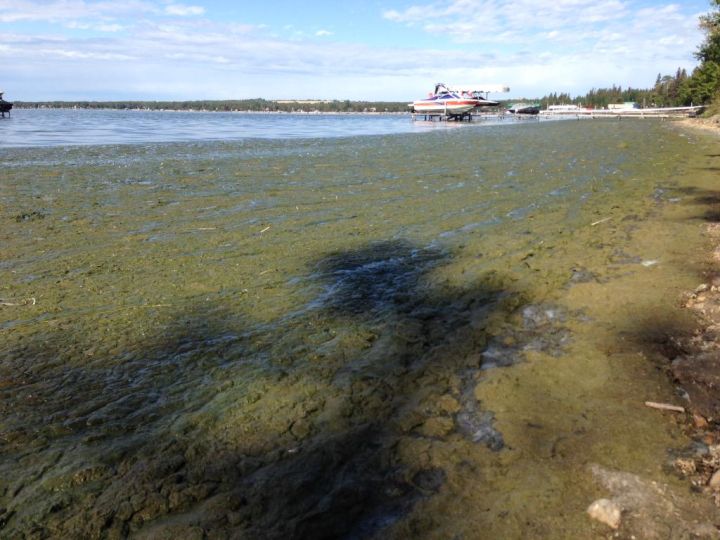It’s a global problem and one that seems to be particularly plaguing Alberta’s lakes, but a professor emeritus with the University of Alberta says new research suggests there’s a course of action governments can take to address blue-green algae showing up in provincial lakes.

“I think the bottom line is we know what to do, we have pretty weak regulations in Alberta,” Dr. David Schindler, lead author of a meta-analysis on the subject published in the journal Environmental Science & Technology earlier this month, says.
READ MORE: Blue-green algae warning issued at Alberta’s Clear Lake, Pine Coulee Reservoir
Schindler’s says algal blooms that render lake water undrinkable and often unswimmable, are caused by a combination of excessive nutrients like phosphorous going into water basins along with higher water temperatures caused by global warming. He blames out-of-control agricultural and cottage development for the surge in phosphorous levels.
He says he believes the Alberta government needs to improve controls on how much agricultural and cottage development goes on near freshwater lakes and not leave those decisions in the hands of municipalities whom he says treat lakes like “cash cows.”
READ MORE: Blue-green algae bloom spotted in Pigeon Lake, despite community’s best efforts
“Pack in more people – it means more business for local businesses and so forth and that has to change,” Schindler says. “I think it’s time that we had some stringent provincial regulations, and in provinces that do – like Ontario – the problem was actually worse 25 to 30 years ago, and they toughened the policies then and a lot of the recovery examples that we show in our paper for example, are from Ontario.”
Schindler and his team’s article is based on long-term data recently released on 37 lakes to see what effect phosphorous control had versus nitrogen control on addressing algae – also known as eutrophication – in water basins.
“The story started in the 1960s and 1970s when a group of us did experiments at the experimental lakes area in Ontario suggesting that the key to controlling eutrophication was phosphorous,” Schindler says. According to him, governments in Canada, the U.S. and Europe adopted this approach with a level of success but invested little in monitoring the lakes once they had declared victory in the war on nuisance blooms of algae.
Watch below: There has been a battle raging in Pigeon Lake over the last few years over blue green algae. Advisories have been issued in the past over dangerous algae. But this year is different. Julia Wong looks into why.

He explains that about 20 years ago, a new wave of researchers suggested phosphorous control alone would not address the algae problem and that nitrogen needed to be controlled as well- something that would cost government’s four to eight times more money.
This new theory prompted Schindler and his colleagues to want to challenge it and see if it was really true.
“Myself and my co-authors looked at the methods and we found some flaws in reasoning and methodology in the phosphorous plus nitrogen group so we decided we’d look at real examples of where whole lakes had been subjected to reductions in one or the other element,” he says. “Our conclusion showed that there were 37 cases where phosphorous control alone had worked (in) every case that we could find data for and in contrast we couldn’t find any evidence that…controlling nitrogen did anything to reduce the problem.”
“I think one of the reasons why people thought phosphorous control was not working was that they were looking at the first two or three years of data and (were) simply too impatient – they expected a miracle to happen and the lakes to resort to their pristine condition immediately after nutrient control – of course that never happens in nature.”
“If you look at the financial implications of this just in Europe and North America, controlling just phosphorous rather than having to control both would save several billion dollars a year,” Schindler says. “I think when we find the least expensive way is the best way (to solve a problem) it’s often a good news story and that’s what we found here.”
According to Schindler, Alberta’s lakes are particularly vulnerable as well because of even before agricultural and cottage development, the watersheds of its lakes are already quite high in phosphorous meaning they are even more vulnerable to the impact of development around them.
READ MORE: Fecal coliforms, algae spark advisories at 2 Alberta lakes
“Water is probably our scarcest resource in Alberta and I think the economics show that that is the number one priority we ought to have is to protect the water supplies,” he says, adding if more isn’t done to protect them, “we’re going to have lots of people with expensive cottages packed around these little pools of green slime that nobody wants to swim in and nobody can drink.”


Comments